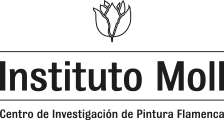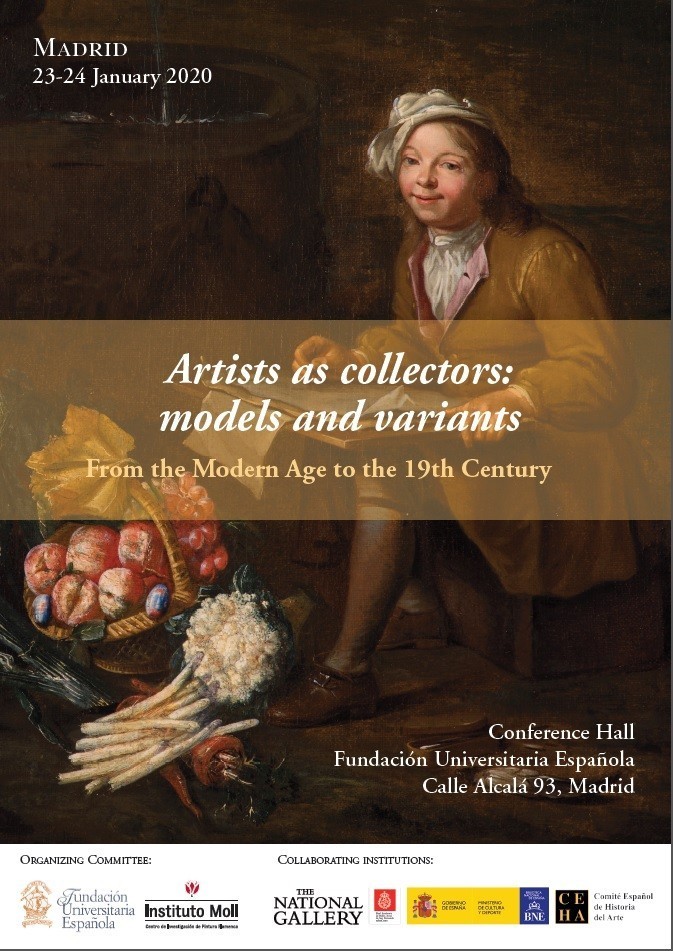International conference: "Artists as collectors: models an variants. From the Modern Age to the 19th Century"
Venue Fundación Universitaria Española (Alcalá 93), Madrid
Dates 23-24 January 2020
Direction: Ana Diéguez-Rodríguez (IM), Ángel Rodríguez Rebollo (FUE)
Coordination: Ana Diéguez-Rodríguez (IM), Ángel Rodríguez Rebollo (FUE)
Organizing: Instituto Moll. Center for Research in Flemish Painting in Spain (IM) & Fundación Universitaria Española (FUE)
Partners: San Fernando Royal Academy of Fine Arts (RABASF), Spanish National Library (BNE), the National Gallery, London and the Comité Español de Historia del Arte (CEHA)
Committees: Itziar Arana Cobos (RABASF); Matías Díaz Padrón (IM/ Academié Belge d´Archéologie et d´histoire de l´Art); Miguel Hermoso Cuesta (UCM); Isabel Clara García-Toraño Martínez (BNE); Anne Robbins (National Gallery, London); Alfonso Rodríguez G. de Ceballos (FUE)
Official languages of the conference: Spanish and English
Key-Words: art; artists; collecting; collections; libraries; engravings; drawings; painting; sculpture; jewels; dress; conservation; workshops; museums; research; dispersion; reflections.
Description/Introduction:
In recent years, the research about the collections that the artists were treasuring throughout their lives, or those collections that they could have had access, is being essential to understand the first inspiration that they could have had for their compositions. The traditional historiography preferred to study the royal and aristocratic collections which could have inspired to the artists, instead of their own collections. Only the collections of great artists as Rubens, Bernini, Velázquez or Mengs have been studied. The artists took the drawings, engravings, sculptures, oeuvres from other artists and, even, the architecture around their workshops as tools and models for their creations. There are examples of this in early times. It is well known the lawsuit between Ambrosius Benson and Gerard David in Bruges in 1519. Benson requested David to return the sketching of paintings, drawings and small panels that belonged to him and he had remained in the David´s workshop. Benson explained as some of those drawings were lent from other artists and he had to pay for renting. Other times, it is when the artist died and the postmortem inventories of his belongings are written when we can see that there are a lot of oeuvres beyond his production, which were important for his own compositions. About this talks Balthasar Gerbier, agent of Charles the first of England, when he writes to the king explaining that, after the Rubens´ death: “the most wonderful paintings, sculptures, agates, ebonies, engravings and drawings from Rubens state will be suddenly sold”. The examples of Vicente Carducho, Alonso Cano or Velázquez are well known in 17th century in Spain. But there are other "minor" artists who also treasured works of art in their houses and workshops, that we know not only by inventories. Antonio Palomino wrote as the Sevillian painter Jerónimo de Bobadilla had "His whole house as a continuous room of things for the study of Painting; full of exquisite models [and], many original drawings [...] ". In England, Thomas Lawrence is a good example to show the fascination about the old master drawings and their role played in the new compositions of the artist. His drawing collection was one of the most important at that moment, and his friendship with the 1st marquis of Abercorn gave him the opportunity to access to the Charles Hamilton collection, the 1st marques of Abercorn´s uncle, to copy the best paintings in his collection. So, architects, painters, sculptors or goldsmiths gathered around their workshops some of the most important artistic collections of their time, where libraries and copies from other artists had also a crucial role, as it was pointed out in research projects in the last years. Since the 18th century, the collection concept changes. The aesthetic taste is developed with the gathering of objects, and the collection of an artist gives us the key to understand his production. The 19th century will also bring novelties, such as those artists who, after a lifetime of hoarding different objects, will donate them in their wills to different institutions or even create their own in order to pass them to posterity. The Seminario de Arte e Iconografía of the Fundación Universitaria Española (FUE) and the Instituto Moll (IM) want to think about the role of those collections and the objects found in them for the artists. Because of it, this call for papers is opened to researchers, professors or students that want to submit a proposal about the artist as collector or the collections in the workshops.
The topic will be discussed through three research lines:
- the collections/libraries of artists and their workshops
- artists as curators
- dispersion and reconstruction of artist´s ancient collections
Registration: 20€ (except attendants with proposals)
The visits to the exhibition at the Prado National Museum and to the San Fernando Royal Academy of Fine Arts, as well as the coffe breaks and the certificate of attendance at the conference are included.
CEHA Members will enjoy a 50% reduction on the rate once they have scanned their membership card and sent it to us by email.
Deadline for registration: 20 January, 2020
congreso@institutomoll.es (download pdf registration)
Call for papers: before June 30, 2019. congreso@institutomoll.es
Important dates:
June 30, 2019 (Deadline for the call for papers)
January 20, 2020 (Deadline for registration)
January 23-24, 2020 (celebration of the congress)
Contact: congreso@institutomoll.es
 Download images
Download images


